| River Jewelwing Calopteryx
aequabilis A species of rivers and small brooks with
rocky or gravelly substrates with sunny exposures, it was formerly fairly common
along the Cross River north of the Kimberly Bridge. Damming of the
river, possibly by beavers, has suppressed the flow in this section of
the river and eliminated the population. Quads G5, I6. May 25
- June 20. |
|
|
|
| Ebony
Jewelwing Calopteryx maculata This is a
common species of small rivers and shady brooks. Formerly abundant on the
Cross River and present along Slawson Brook and other small brooks on
the reservation. It is commonly seen away from water, as well. Numbers
may be reduced due to damming of the Cross and Waccabuc Rivers, possibly
by beavers, but still present.
Quads C12, D4, D7, E4, E5, E6, F4, F6, G4, G5, I4, I5, I6. May 21 -
September 12. |
|
|
|
| Spotted Spreadwing
Lestes congener A late season species of small
ponds. At WPRR, it should be looked for at the end of Michigan Road.
Quad D7. August 25 - October 23. |
|
|
|
| Common Spreadwing
Lestes disjunctus australis A species of vernal
ponds. Its current status at WPRR is uncertain. Quad D3. June 16. |
|
|
|
| Emerald Spreadwing
Lestes dryas A generally northern species of
small ponds and emergent marshes. Not believed to currently inhabit WPRR.
Quads D3, D7. June 16 - July 27. |
|
|
|
| Amber-winged Spreadwing
Lestes eurinus A local species of vernal pools
and fishless ponds. Not currently found at WPRR, but it may establish
temporary populations and could turn up again. Quad D3. June 16. |
|
|
|
| Sweetflag Spreadwing
Lestes forcipatus A locally common species of
vernal ponds and emergent marshes. It should be looked for at the end of
Michigan Road. Quads C12, D7. July 19 - October 13. |
|
|
|
| Slender Spreadwing
Lestes rectangularis A species of ponds, swamps,
marshes, and vegetated stream banks, this is perhaps our most widespread
spreadwing. At WPRR, it is often found at the end of Michigan Road.
Quads C12, D7, G4, G5. July 19 - October 13. |
|
| |
|
| Swamp Spreadwing
Lestes vigilax This is a species of lakes and large ponds
with emergent vegetation. Such habitat does not occur at the reservation,
but the species is known to wander. A male individual was found on a
slack water spot along the Cross River June 28, 2014. Quad G5. |
|
|
|
| Violet Dancer Argia
fumipennis violacea This
common species of small to medium-sized rivers, ponds, and lakes breeds
on the Cross and Waccabuc Rivers. It is also seen frequently along the
section of Boutonville Road between the two rivers. Quads C4, G5. May 30
- September 9. |
|
|
|
| Powdered Dancer Argia
moesta This a species of
clear, medium sized to large rivers. Formerly a common sight throughout the
summer on the Cross River, north of the Kimberly Bridge, especially on
rocks protruding above the water's surface. Damming of the river,
possibly by beavers, has suppressed the flow in this section of the
river and negatively impacted the population. Small numbers found to
persist in 2019. Quads D4, E4, F4, G4, G5.
June 5 - September 22. |
|
|
|
| Aurora Damsel Chromagrion
conditum This species is found
around seeps, swamps, emergent marshes, ponds, and vegetated stream
banks. At WPRR, it is best around the Michigan Road waters. Quads C9,
D7, E7, F4, G5. May 21 - July 6. |
|
|
|
| Eastern Red Damsel Amphigrion
saucium This species is
associated with sunny, sedgy seeps and wet meadows. Current status
unclear. Quad E5. June 2 -
June 27. |
|
|
|
| Familiar Bluet Enallagma
civile A common species of lakes and
ponds, but wanders extensively and commonly seen away from water. May be
found in meadows throughout WPRR. Quads D4, D7. June 5 - September 24. |
|
|
|
| Azure Bluet Enallagma
aspersum A fairly common species
preferring fishless ponds. It wanders widely and may establish temporary
populations where conditions are right. At WPRR, should be looked for at
the small ponds just beyond the entrance booth and the pond near the end
of Michigan Road. Quad C4. August 5. |
|
|
|
| Turquoise Bluet Enallagma
divagans A species of small to
medium sized large rivers and lake shores. At WPRR, could be sometimes
found
in years with higher water levels along the Cross River north of the
Kimberly Bridge. Damming of the river, possibly by beavers, has
suppressed the flow in this section of the river and put future
sightings into question. Quads D7, G5, I5. June 4 - July 2. |
|
|
|
| Stream Bluet Enallagma
exsulans A species of medium sized
streams to large rivers and lake shores, at WPRR was formerly fairly common along the
Cross River north of the Kimberly Bridge. Damming of the river, possibly
by beavers, has suppressed the flow in this section of the river and has
probably negatively impacted the population. Quads D4, G5. June 16 - August
15. |
|
|
|
| Skimming Bluet Enallagma
geminatum A common species of lakes,
ponds, and slow streams. Quads B4, D3, G5. June 16 - July 31. |
|
|
|
| Hagen's Bluet Enallagma
hageni This species is best found at
marshy ponds, especially those with tussock sedge. This habitat occurs
at WPRR at the end of Michigan Road and the species should be looked for
in years with higher water levels. But last recorded in 2005. Quads D3, D7. June 16 - June 28. |
|
|
|
| Orange Bluet Enallagma
signatum A generally common species
of lakes, ponds, and slow streams. Current status in WPPR uncertain. Quad D3. June 16. |
|
|
|
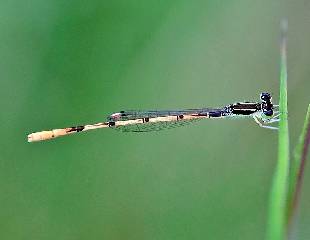 |
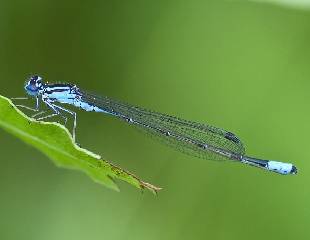 |
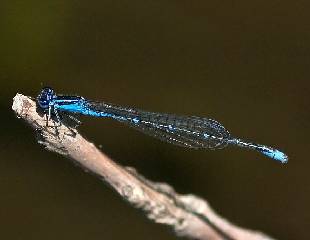 |
| Citrine Forktail, July 26, 2009. |
Turquoise Bluet, June17, 2006 |
Stream Bluet, July 8, 2007 |
|
|
|
|
| Vesper Bluet Enallagma
vesperum This species' breeding
habitat of lakes and large ponds is not present within WPRR. The lone
WPRR record is of an individual found at night, having been attracted to
a black light set up for moths August 4, 2007. Quad C6. |
|
|
|
| Eastern Forktail Ischnura
verticalis One of the most
widespread damselflies of the area, it may be found around ponds,
marshes, ditches, wet meadows, swamps, lake shores, and river shores.
Quads B4, C4, C9, D7, F10, G5, I4, I6. May 4 - September 11. |
|
|
|
| Fragile Forktail Ischnura
posita A common and widespread
species, found around ponds, marshes, ditches, wet meadows, and stream
banks. Quads C9, D3, D7, G5. May 13 - September 11. |
|
|
|
| Citrine Forktail Ischnura
hastata This species favors shallow
ponds and marshes with vegetated margins. It is uncommon at WPRR but
should be looked for in the grassy areas bordering the marsh at the end
of Michigan Road. Quad D7. June 7 - September 24. |
|
|
|
| Furtive Forktail Ischnura
prognata This is a southern species
that is exceptionally rare in New York. It is represented at WPRR by a
single male collected June 16, 1990 and confirmed by several
authorities. Quad G5. |
|
|
|
| Sphagnum Sprite Nehalennia
gracilis Current status unknown. A
local species of bogs, sphagnum-sedge meadows, and sphagnum regions of
vernal ponds. Quads C12, D3. June 16 - July 29. |
|
|
|
| Sedge Sprite Nehalennia
irene A species of wet meadows and
grassy or sedgy seeps. At WPRR, should be looked for around the marsh at
the end of Michigan Road. Last recorded in 2010, however. Quads D3, D7, G5. May 29 - July 18. |
|
|
|
| Common Green Darner Anax
junius The ubiquitous Green Darner
may be found in swarms or flushed from fields throughout WPRR. Breeding
habitats are any of the still waters in the reservation. Quad
D7. Recorded at least through September 24. |
|
|
|
| Canada Darner Aeshna
canadensis This pond species
is one of the more common mosaic darners at WPRR and elsewhere in
Westchester. It is often present in late summer, patrolling the waters
at the end of Michigan Road. It may occasionally be found perched. Quad
D7. July 26 - October 10. |
|
|
|
| Lance-tipped Darner Aeshna
constricta This uncommon pond
species was only known from one specimen as of 1996 list. It has since
been found with some regularity at the end of Michigan Road, especially
in late July. Quad D7. July 25 - September 11. |
|
|
|
| Black-tipped Darner Aeshna
tuberculifera Of the mosaic
darners known from WPRR, this pond species is the least common. It
should be looked for at the end of Michigan Road. Quad D7. July 24
- October 10. |
|
|
|
| Shadow Darner Aeshna
umbrosa A fairly common
species of ponds, swamps, and streams. Unlike other members of its
genus, it prefers woodlands. Feeding individuals may, however, be seen
over fields, often flying to near dusk. Quads D7, E7. June 28 -
October 21, but scarce before August. |
|
|
|
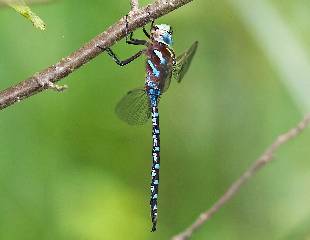 |
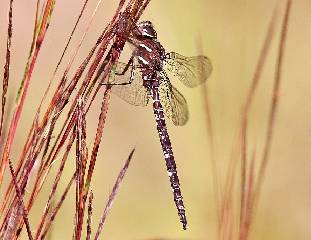 |
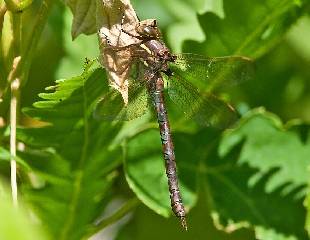 |
| Lance-tipped Darner, July 26, 2008. |
Shadow Darner, September 6, 2009 |
Cyrano Darner, June 16, 2007 |
|
|
|
|
| Green-striped Darner Aeshna
verticalis An uncommon species
of marshes, it can be expected in late summer, in non-drought years, at
the end of Michigan Road. Quad D7. July 27 - September 17. |
|
|
|
| Spatterdock Darner Rhionaeshna
mutata A species of vegetated
ponds, it was not known at WPRR as of 1996. Its occurrence is erratic
and probably not annual, but it may turn up in open areas throughout the
reservation. Quads D7, I5. June 3 - June 8. |
|
|
|
| Springtime Darner Basiaeschna
janata A species of small to
large rivers, as well as lake shores. Often seen patrolling the Cross
and Waccabuc Rivers, although its rapid flight may not afford good
looks. Better looks are possible from occasional perched individuals,
particularly in the sand pit near the end of Boutonville Road. Quads C9,
D7, G5, G8, I4, I5. May 10 - June 16. |
|
|
|
| Fawn Darner Boyeria
vinosa A common species of
brooks, streams, and rivers. At WPRR, formerly most easily seen in late summer
along the Cross River near the Kimberly Bridge. With less specialized
requirements than other stream species, it should still be present, but
will have to be monitored as a result of the damming of the river. Quads E6, G5. July
19 - October 13. |
|
|
|
| Swamp Darner Epiaeschna
heros This species utilizes
swamps, vernal ponds, and seeps for breeding. It is highly migratory and
can turn up anywhere -- it is not unusual to see one flying over city
streets. Quads C9, D3, D7, F5, G5. May 21 - September
14. |
|
|
|
| Harlequin Darner Gomphaeshna
furcillata This is a species
of swamps, emergent marshes, bogs, and fens. It may be seen in
continuous flight like other darners, but it is also famous for landing
on walls and even people. Quads C9, D3, D7, E7, G5, H5, I5. May 21
- July 2. |
|
|
|
| Cyrano Darner Nasiaeschna
pentacantha This species
prefers slow streams, small ponds, and quite bays, particularly with
wooded edges. Males are typically seen patrolling endlessly over
territory. Individuals are seldom seen at rest. This is one species that
seems to be benefitting from the damming situation affecting the Cross
River. Quads D3, G5,
H5, I5. May 26 - July 7. |
|
|
|
| Unicorn Clubtail Arigomphus
villosepes This species breeds at
ponds and is typically seen at the water's edge. It should be looked for
at both the pond and marsh at the end of Michigan Road. June 5 - July
30. Quads D6, D7. |
|
|
|
| Lancet Clubtail Gomphus
exilis This species may breed in
lakes, ponds, and streams. It is very common at WPPR. It is seen
primarily on the Cross and Waccabuc Rivers, and in between along
Boutonville Road. A few can also be found at the Michigan Road waters.
Quads C4, D7, E7, F5, G5, I4, I6. May 26 - July 7. |
|
|
|
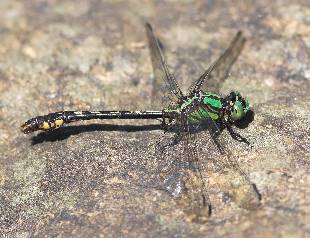 |
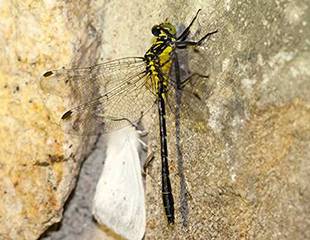 |
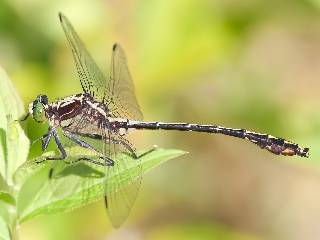 |
| Maine Snaketail, June 16, 2007 |
Southern Pygmy Clubtail, May 29, 2011 |
Black-shouldered Spinyleg, July 30, 2006 |
|
|
|
|
| Ashy Clubtail Gomphus
lividus This is a common to abundant
species at WPRR. It breeds on the Cross River, but is commonly found
along Boutonville Road. Quad G5, I4, I5, I6. May 20 - July 3. |
|
|
|
| Black-shouldered Spinyleg Dromogomphus
spinosus This large clubtail breeds
on medium to large rivers and large lakes. These habitats don't occur on
the reservation, but do occur just outside and the species wanders
regularly into the reservation. Sightings may occur virtually anywhere
within WPRR. May 30 - August 13 (September 9 just outside WPRR). Quads
D7, E6. |
|
|
|
| Dragonhunter Hagenius
brevistylus This is the largest of
the clubtails, with a preference for small to medium sized rivers. It is
never numerous but always present throughout the summer at WPRR.
Historically, it's
most often seen along the Cross River, but damming of the river may
change that. This species may still turn up in open areas
anywhere in the reservation. Quads D7, E4, F4, G4, G5, H5. June 4 -
August 25. |
|
|
|
| Southern Pygmy Clubtail Lanthus
vernalis This is a species of small,
perennial, cold-water brooks, and forest rivulets. At WPRR, it is
found primarily along Slawson Brook, from where it occasionally wanders
to the area around the Trailside Museum. Quads E5 (nymphs), F5, D6, D7. May
28 - June 25. |
|
|
|
| Maine Snaketail Ophiogomphus
mainensis Formerly common on the
Cross River near the Kimberly Bridge, where males
could be found sitting on rocks in the river. Damming of the river,
possibly by beavers, has suppressed the flow in this section of the
river. May 25 - July 8. Quads
E4, F4, F5, G5. |
|
|
|
| Least Clubtail Stylogomphus
albistylus Likely no longer present. A few individuals
were usually present in
mid-summer on the Cross River north of the Kimberly Bridge, with males
sitting conspicuously on rocks in the river. Damming of the river,
possibly by beavers, has suppressed the flow in this section of the
river. June 8 - August 17. Quads
C4, E4, F4, G5. |
|
|
|
| Zebra Clubtail Stylurus
scudderi This species breeds on
medium sized, forest-bordered rivers, especially with sandy substrates.
Its range is primarily well north of the reservation. A disjunct
population formerly occurred on the Cross River. The species has not
been seen here since 1990. July 27 - August 7. Quad G5. |
|
|
|
| Delta-spotted Spiketail Cordulegaster
diastatops Historically the most common
of the spiketails at WPRR, and frequently seen in meadows throughout the
reservation. Breeding habitats include sunny seeps,
rivulets in wet meadows, and small sunny brooks. It might best be found on Slawson Brook.
Current status in question due to the apparent loss of the Cross River
as viable breeding habitat. May 30 - July 7. Quads E5, E6, F5, G5, H5. |
|
|
|
| Tiger Spiketail Cordulegaster
erronea This species is associated
with spring runs or small perennial spring-fed cold water brooks. At
WPRR, almost all sightings are of individuals patrolling Slawson Brook.
July 11 - August 4. Quads E6, F6. |
|
|
|
| Twin-spotted Spiketail Cordulegaster
maculata Small to large rivers are
the habitat of this spiketail. It can be looked for on Slawson Brook, seldom being encountered away from water.
Formerly observed on the Cross River, but damming of the river, possibly
by beavers, has suppressed the flow on the river. May 30 - June
29. Quads E5, E6, G5. |
|
|
|
| Arrowhead Spiketail Cordulegaster
obliqua This species was not
recorded by Soltesz. It was first discovered at WPRR in 2004 and has
been annual since. It breeds on small forest brooks and can be seen
patrolling the stream near the end of Michigan Road. It may also turn up
elsewhere in the reservation, away from the breeding water. May 30 -
July 26. Unconfirmed to August 1. Quads D7, E5, H5. |
|
|
|
| Stream Cruiser Didymops
transversa This is a fairly common
species of small to medium sized rivers. Once easily found patrolling
the Cross River north of the Kimberly Bridge and the Waccabuc River at
the east end of Boutonville Road. Damming of these rivers, possibly by
beavers, has probably negatively impacted the population. This species may also be encountered away from
water. May 4 - June 13. Quads E10, F10, G5, G8, G9, I5, I6. |
|
|
|
| Swift River Cruiser Macromia
illinoiensis An uncommon species of
rivers and large lakes, with only two records for WPRR, and in fact
Westchester County. The first was netted from a small swarm of
dragonflies in a woodland clearing at the end of Michigan Road,
photographed, and released August 3, 2003. A second individual was
photographed by Clarence Holmes near the Meadow parking area July 21,
2007. Quads D4, D7. |
|
|
|
 |
 |
 |
| Tiger Spiketail, July 30, 2006. |
Illinois River Cruiser, August 3, 2003. |
Mocha Emerald, August 4, 2007. |
|
|
|
|
| Mocha Emerald Somatochlora
linearis This species breeds on
small, shaded streams. The first WPRR record was a female, netted from
the same swarm as the Illinois River Cruiser August 3, 2003. It was
photographed and released. A male was found patrolling possible breeding
habitat and photographed at rest alongside Slawson Brook August 4, 2007.
A pair of emeralds, including an ovipositing female, thought to be this
species were observed on the woodland brook at Michigan Road August 1,
2015. Quads D7, F7. |
|
|
|
| Clamp-tipped Emerald Somatochlora
tenebrosa This is the common emerald
of the reservation. Its breeding habitats include muddy brooks,
headwater seeps, and spring runs. It is mostly seen away from water,
often in small feeding swarms. The best areas to look for this are in
the meadow adjacent to the Meadow parking lot and the fields at the end
of Michigan Road. July 2 - September 2. Quads C6, D4, D7, E5, F4. |
|
|
|
| Brush-tipped Emerald Somatochlora
walshii This species prefers marshy
brooks and emergent marshes. It was first found at WPRR July 28, 1996
and is most likely of annual occurrence now. Although possibly seen
elsewhere on the reservation, all definite sightings have been over the
meadows at the end of Michigan Road. July 8 - July 28. Quad D7. |
|
|
|
| Racket-tailed Emerald Dorocordulia
libera This species is best found at
marshy ponds, especially those with tussock sedge. This habitat occurs
at WPRR at the end of Michigan Road and the species should be looked for
in years with higher water levels. May 30 - July 2. Quad D7. |
|
|
|
| Common Baskettail Epitheca
cynosura One of the most abundant
dragonflies at WPRR, it is typically seen in flight over open areas
throughout the reservation, often in large swarms. It utilizes ponds and
slow streams for breeding. May 20 - July 3. Quads C4, C5, D7, F5,
G5, I4, I5. |
|
|
|
| Prince Baskettail Epitheca
princeps This species is a very
common sight in the skies over WPRR, often far above the ground. It is
almost never seen at rest. Breeding habitats include lakes and rivers.
May 26 - July 31. Recorded just outside the reservation August 16. Quads D4, D7, G5. |
|
|
|
| Calico Pennant Celithemis
elisa This species breeds in marshy
ponds, but WPRR sightings are mainly away from water. This colorful
insect is a common sight in meadows throughout the reservation,
typically perched at the tips of grasses. May 30 - September 9. Quads
D4, D7, F5, H5, I5. |
|
|
|
| Halloween Pennant Celithemis
eponina This species' habitats are
similar to the Calico Pennant, but this one is typically more numerous
at the reservation. June 2 - September 9. Quads B4, D4, D7, E5, G5, H5,
I5. |
|
|
|
| Eastern Pondhawk Erythemis
simplicicollis This is a species of
lakes, ponds, and marshes. It may be seen at the water's edge or in
meadows, mainly in the Michigan Road area. May 26 - September 2. Quad
D7. |
|
|
|
| Chalk-fronted Corporal Ladona
julia This is an abundant pond
species to the north of WPRR and in higher elevations, but seldom
encountered at the reservation. May 30 - June 25. Quads D7, E7, I6. |
|
|
|
| Frosted Whiteface Leucorrhinia
frigida This species breeds in
marshy ponds, and especially with tussock sedge, such as the marsh at
the end of Michigan Road. The species is never common at WPRR and less
than annual, but it should be looked for in years with high water. May
30 - June 21. Quad D7. |
|
|
|
| Dot-tailed Whiteface Leucorrhinia
intacta This is a pond species. It
can often be found at the pond and marsh near the end of Michigan Road.
May 5 - July 3. Quad D7, D10. |
|
|
|
| Red-waisted Whiteface Leucorrhinia
proxima This is a northern species,
first found at WPRR in 2007. Several were found in the marsh at the end
of Michigan Road in 2011, where it may be confused with the very similar
Frosted Whiteface. June 15 - July 2. Quad D7. |
|
|
|
| Bar-winged Skimmer Libellula
axilena This is a southern species
of vernal ponds and fishless, marshy ponds. It is absent from New York
State in most years, but occasionally irrupts northward. 1995 was one
such year and the species was seen in the marsh at the end of Michigan
Road from June 4 to July 29 (same individual?). Quad D7. |
|
|
|
| Spangled Skimmer Libellula
cyanea This species breeds in ponds
and marshes. A common sight at WPRR, it may also be found in meadows.
May 26 to July 31 (probably later). Quads B4, D7. |
|
|
|
| Slaty Skimmer Libellula
incesta This is a species of lakes
and larger ponds, habitats that are not featured at WPRR. It may be
found, however, at the pond near the end of Michigan Road in years with
higher water levels. June 5 to September 6. Quads B4, D7. |
|
|
|
| Widow Skimmer Libellula
luctuosa This is a species of ponds,
lakes, and slow streams. It is a very common sight in meadows throughout
WPRR. June 4 to October 5. Quads B4, C4, D7, E5, F5, G5. |
|
|
|
| Twelve-spotted Skimmer Libellula
pulchella This is a highly migratory
dragonfly that breeds at ponds and marshes. At WPRR, it is best found at
the pond near the end of Michigan Road, where it perches conspicuously
on pond side bushes. May 30 - September 12. Quads C5, D7, G5. |
|
|
|
| Painted Skimmer Libellula
semifasiciata This is another
migratory dragonfly that can be found virtually anywhere in the
reservation when it arrives in early spring. Preferred breeding habitats
are bogs and marshy ponds. It is most reliably found in the marsh at the
end of Michigan Road. May 5 - August 20. Quads C9, D7, G7. |
|
|
|
| Four-spotted Skimmer Libellula
quadrimaculata This is a northern
species with a preference for sedge marshes. At WPRR, it has been found
at the marsh and pond at the end of Michigan Road. It occurred regularly
through the much of the 1990's, was absent for several years, and has
been sporadic over the last 7. June 16 - July 8. Quad D7. |
|
|
|
| Great Blue Skimmer Libellula
vibrans This is a southern species
that irrupts northward in some years, on occasion becoming common at
small ponds, vernal pools, and slow streams. When present at WPRR, it is
best found at the woodland pond northwest of the Meadow parking lot.
June 16 - August 16. Quads D3, D7, G5. |
|
|
|
| Common Whitetail Plathemis
lydia This is one of the most
frequently encountered dragonflies in the northeast, regularly
encountered along trails, roadsides, and in fields. Breeding habitats
are ponds, marshes, and slow streams. May 5 - September 2. Quads C9, D7,
G9, I4, I5, I6. |
|
|
|
| Blue Dasher Pachydiplax
longipennis One of the most abundant
dragonflies of the northeast, this species is at home at lakes, ponds,
and marsh-edged streams. At WPRR, mainly found at the end of Michigan
Road, both at the water habitats and in the fields. June 4 - July 31.
Quads D4, D7, G5. |
|
|
|
| Wandering Glider Pantala
flavescens As the name of this
dragonfly might indicate, this is a migratory species. Numbers are
variable from year to year, and great numbers may sometimes be observed
migrating along the coast. Breeding may be in rain pools, puddles,
temporary and artificial ponds. Typical WPRR sightings are of
individuals in flight, often in swarms with other species. August 4 -
September 2. Quads D4, D7, G5. |
|
|
|
| Spot-winged Glider Pantala
hymenaea This species' habits are
much like that of the Wandering Glider, but numbers tend to be less
variable from year to year. June 5 - August 16. Quads D4, D7. |
|
|
|
| Eastern Amberwing Perithemis
tenera This is a tiny, distinctive
dragonfly of ponds, lakes, and slow streams. Individuals are commonly
found in fields. June 26 - August 18. Quads B4, D7, G5, I5. |
|
|
|
| Cherry-faced Meadowhawk Sympetrum
internum This small red species is
an abundant dragonfly of ponds, marshes, and slow streams. It may be
found away from water and is the most likely of the meadowhawks to be
seen in mid summer. June 10 - October 10. Quads C12, D7, I4. |
|
|
|
| Band-winged Meadowhawk Sympetrum
semicinctum Another small red
species, this dragonfly is more at home in marshy habitats, including
ponds, brooks, and meadows. It should be looked for around the marsh at
the end of Michigan Road, particularly in September. July 27 - October
10. Quad D7. |
|
|
|
| Autumn Meadowhawk Sympetrum
vicinum This is another small red
species of ponds, marshes, and slow streams. Although individuals may
emerge as early as June, they are most easily found when breeding begins
in September. This species is famous for its late flight period, with
regional records extending into December in warm years. August 7 -
October 23. Quads C4, D7, E7, G5, I4. |
|
|
|
| Carolina Saddlebags Tramea
carolina This is species is seen in
New York mainly as a breeder on Long Island ponds and lakes and as a
migrant along the coast. Its travels may on rare occasions bring it to
WPRR, where it may be seen in feeding swarms with other species. June 5
- September 24. Quads D4, D7. |
|
|
|
| Black Saddlebags Tramea
lacerata This is a common, highly
migratory species. It favors ponds and lakes for breeding. Typical WPRR
sightings are of individuals in flight, often in swarms with other
species. June 5 - September 24. Quads D4, D7, F5. |
|











